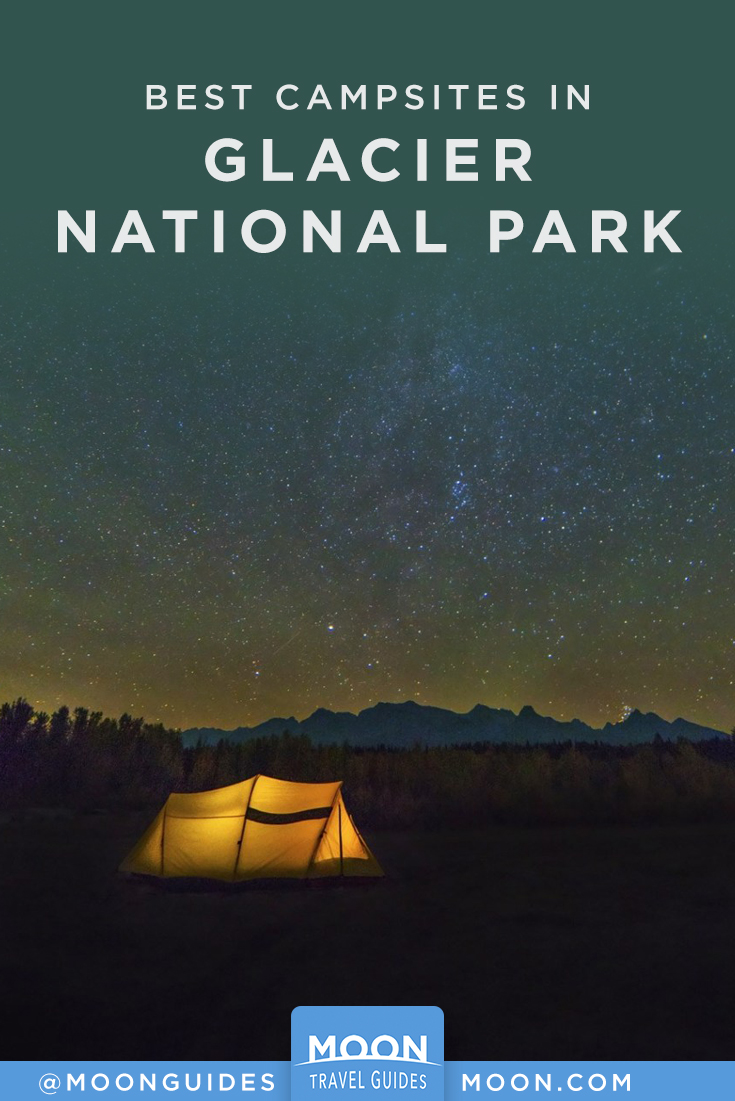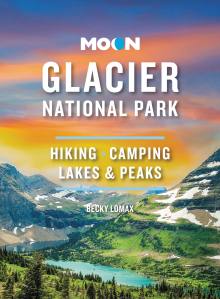Best Campsites in Glacier National Park
While Glacier National Park houses a number of top-notch lodges, there’s no better way to immerse yourself in the park’s wild, rugged beauty than to camp under its crystal-clear skies, surrounded by the quiet humming of nature. Choose from any of the following campsites inside the park for the full Glacier experience. Keep in mind that most of the campgrounds within the park operate on a first-come, first-served basis—though St. Mary and Many Glacier accept some reservations starting six months in advance. Without a reservation, plan on arriving early, as these popular spots can fill up fast. Happy camping!
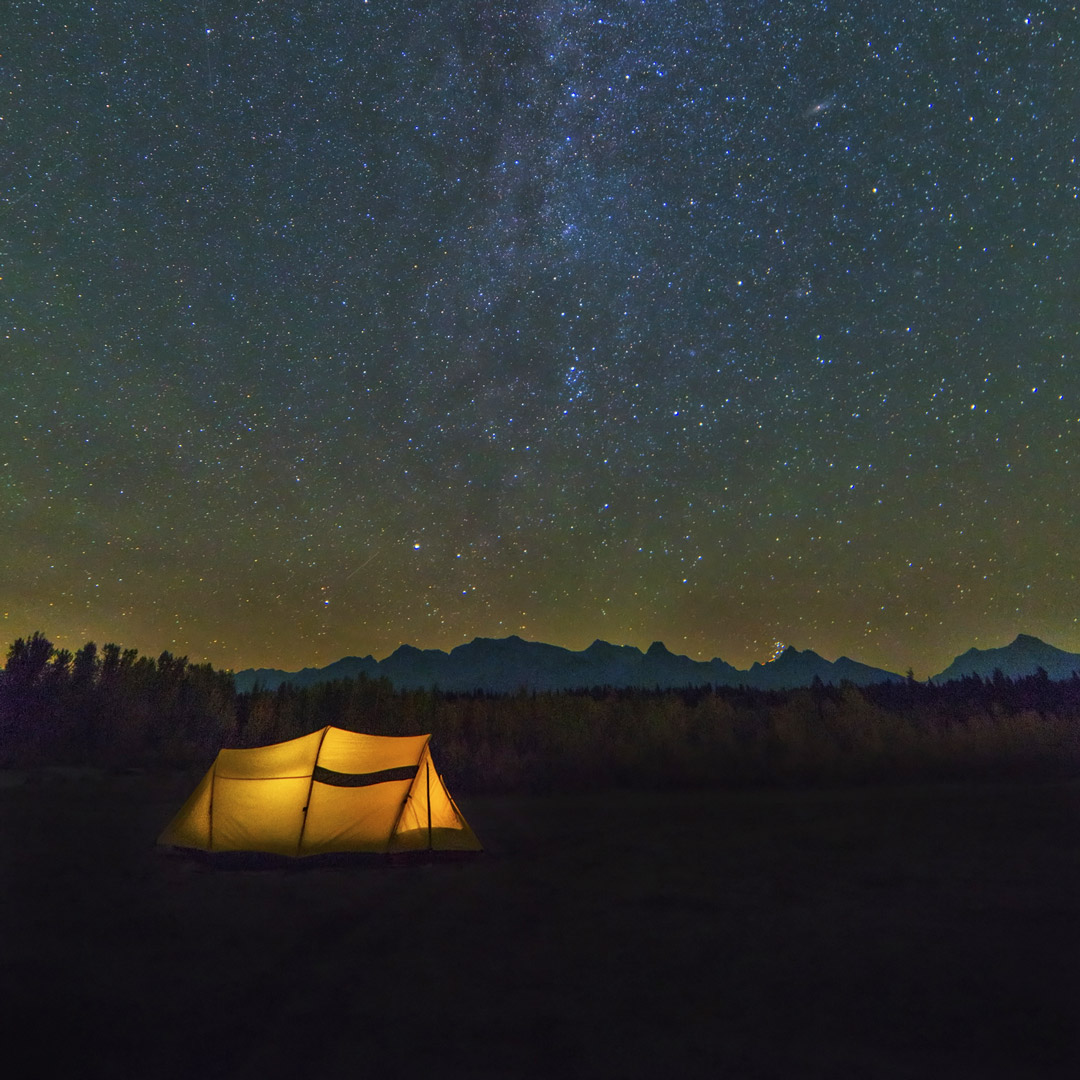
West Glacier and Apgar Campgrounds
Two National Park Service-operated campgrounds flank Lake McDonald with sites under a forest canopy. Rustic and without hookups, they have flush toilets, fire rings with grills, disposal stations, shared hiker-biker sites, amphitheaters for evening naturalist talks, and sites that accommodate large RVs. Due to the lakeside location inside the park, away from highway and railroad noise, they are popular. Midsummer, they fill up by 8am-9am. Bring your own firewood; collecting wood is prohibited.
Fish Creek Campground
Fish Creek Campground, one of two campgrounds in the park that can be reserved starting six months in advance (877/444-6777, www.recreation.gov), is one of the larger park campgrounds, with 178 sites tucked under cedars, lodgepole pines, and larches. Loops C and D have the best sites, adjacent to the lake, although Loop B has some larger, more level sites. A few lukewarm token-operated showers are available. Eighteen campsites accommodate RVs up to 35 feet long; 62 sites fit RVs up to 27 feet. To find Fish Creek, drive 1.25 miles north from Apgar on Camas Road and turn right, dropping one mile down to the campground. Lake McDonald Trail departs from the campground.
Apgar Campground
Apgar Campground is within a short walking distance of Apgar Village, Lake McDonald, and the shuttles. The campground has 194 sites, making it the park’s largest, with group campsites too. For RVs, 25 sites fit up rigs to 40 feet. A paved trail connects with the Apgar Transit Center, the visitors center, and the Apgar Bike Trail. A separate walking path leads to Apgar Village’s restaurant, gift shops, and boat dock. Primitive camping has pit toilets available but no running water. In winter, you can camp free at the plowed Apgar Picnic Area. A pit toilet is there.
McDonald Lake (Backcountry Campsite)
Lake McDonald has one prime backcountry campsite on the north shore, accessible by foot, paddling, or motorboat. It perches on a point with huge views up and down the lake, plus outstanding night sky watching. It has a communal cooking site, a fire pit, a pebble beach, and two large tent sites that can sleep four people each. Pick up required overnight permits in person at the Apgar Backcountry Permit Office 24 hours in advance. You can also apply online for advance reservations starting in mid-March (www.nps.gov/glac).

North Fork Campgrounds
National park or national forest campgrounds are the norm. These rustic camps are first-come, first-served. Small, private campgrounds are minus hookups. If you require hookups and disposal stations, go to West Glacier or Columbia Falls.
Glacier’s seasonal North Fork campgrounds are only accessible via rough dirt roads. Between rugged roads and smaller sites, these campgrounds don’t accommodate huge RVs or large trailer combinations. But that’s precisely their attraction: Fewer people equals solitude and quiet. They have pit toilets, fire rings, and picnic tables. While the park prohibits firewood collecting in most places, including the campgrounds, you can collect dry, downed firewood on the Bowman Lake Road and the Inside Road to Kintla Lake. Cutting live timber is not permitted. Early September-October, Bowman and Kintla Campgrounds permit primitive camping ($10). Bring water or haul it from lakes and streams to boil or purify. The four campgrounds are buggy in June, serene in August, and closed in winter when the roads are buried in snow. Midsummer, Kintla and Bowman can fill up by 11am Friday-Saturday and midafternoon Sunday-Thursday.
Kintla Lake Campground
At the foot of Kintla Lake, Kintla Lake Campground is 15 miles north of Polebridge. The tiny 13-site campground is tucked under large trees, with hand-pumped water and small sites. One hiking trail leads up-lake and beyond to Upper Kintla Lake and Boulder Pass. If you don’t have reservations, plan to arrive early enough that if all the campsites are full, you can still drive back toward Bowman Lake.
Bowman Lake Campground
At the foot of Bowman Lake, Bowman Lake Campground is seven miles from Polebridge. Its 48 sites, the largest of the North Fork’s campgrounds, spread out under a mixed conifer forest. It has running water, and a five-minute walk leads to the lakeshore and the boat ramp. Trails connect to Quartz Lakes, Numa Lookout, Akokala Lake, and up Bowman Lake to Brown Pass.
Quartz Creek and Logging Creek Campgrounds
Two tiny campgrounds flank the Inside Road in the woods south of Polebridge. They are best for tent campers who can drive the rugged road. No running water is available, so bring your own or plan to purify stream water. Arrive by midafternoon to allow plenty of time to go elsewhere if either campground is full.
With seven campsites, Quartz Creek Campground sits six miles southeast of Polebridge adjacent to Quartz Creek. From the campground, a 6.8-mile rough trail with infrequent maintenance follows the creek up to Lower Quartz Lake. Located 8.3 miles southeast of Polebridge, Logging Creek Campground, adjacent to Logging Creek Ranger Station, has only seven sites. This is a popular site for anglers heading to Logging Lake.
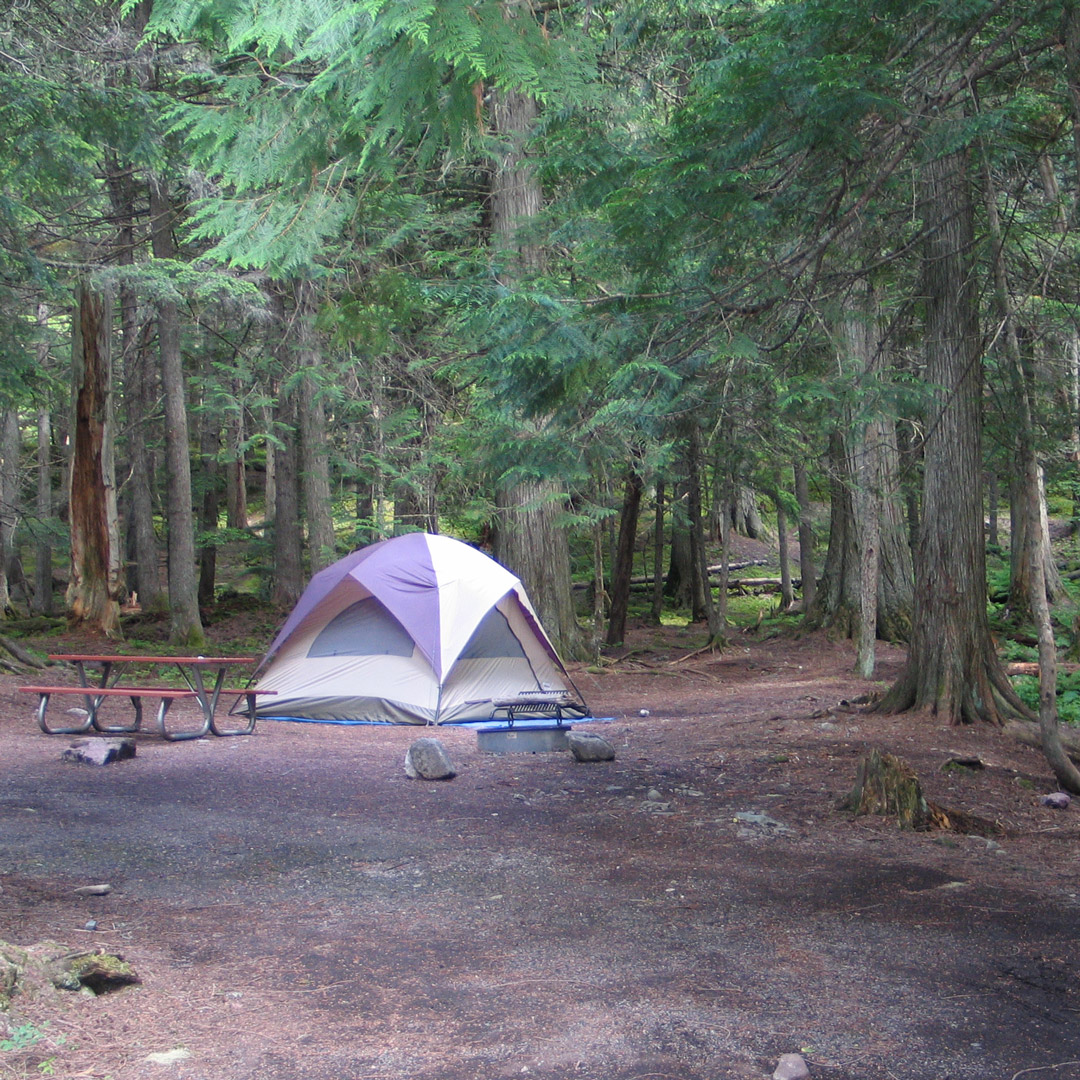
Going-to-the-Sun Road Campgrounds
In the 50 miles of Going-to-the-Sun Road, five campgrounds stretch along the corridor, but none sit in the high alpine Logan Pass section. On the west side, Apgar, Sprague Creek, and Avalanche offer more sites than Rising Sun and St. Mary on the east side. In midsummer, the coveted Avalanche, Sprague Creek, and Rising Sun Campgrounds can fill up by early morning; all sites are first-come, first-served. Amenities include shuttle stops, flush toilets, cold running water, picnic tables, and fire rings with grills; bring your own firewood, as collecting is prohibited. Shared sites accommodate hikers and bikers with bear-resistant food storage. For hookups, hit commercial campgrounds outside the park in St. Mary or West Glacier.
If campgrounds are full, oversize RVs must backtrack, because vehicles over 21 feet cannot travel the Sun Road between Avalanche Campground and Sun Point. On the west side, head to Fish Creek and commercial campgrounds in West Glacier. On the east side, aim for commercial campgrounds in St. Mary. For RVs seeking a dump station, find the closest west-side one at Apgar; Rising Sun Campground has a dump station on the east side.
Sprague Creek Campground
Sprague Creek Campground is right on Lake McDonald’s shore in a timbered setting with shaded sites. A few have prime waterfront. Unfortunately, several sites also abut Going-to-the-Sun Road, with a nice view of cars driving by. After dark, the road noise plummets, so it’s not like tenting next to a major highway. As the smallest campground with only 25 sites accessed via a paved road, Sprague Creek does not allow towed units. Most of the parking pads are short and narrow, but a few can fit small RVs up to 21 feet. Kayakers and canoers have lakefront access, and beach sunsets rank as spectacular. At 22 miles from Logan Pass, it has quick access to the high country, and it’s five minutes from Lake McDonald Lodge and the camp store. Midsummer, Sprague often fills by 8am.
Avalanche Campground
Set in a cedar-hemlock and fern rainforest, Avalanche Campground opens its 87 sites for a shorter season than Sprague Creek. Six miles east of Lake McDonald Lodge, Avalanche makes the closest west-side base for exploring Logan Pass, 16 miles away, and is convenient for hiking to Avalanche Lake, since the trail departs from the campground’s rear. The rainforest, with its dark, overgrown forest canopy, allows little sunlight to hit picnic tables. The moist area sprouts thick patches of thimbleberries and sometimes a good collection of mosquitoes. RVs are limited to 26 feet. Midsummer, Avalanche can fill before 10am.
Rising Sun Campground
Located only 12 miles east of Logan Pass and 6 miles west of St. Mary, Rising Sun Campground tucks on the lower hillside of Otokomi Mountain by St. Mary Lake. The sun drops down early behind Goat Mountain, creating a long twilight at the campground. While the 2015 Reynolds Creek Fire bypassed the larger trees in the lower campground, it left burnt trees on the hillside above the upper campsites. Adjacent to Rising Sun Motor Inn, the 83-site campground is a few minutes’ walk to a restaurant, a camp store, and hot showers. Beach access is across Going-to-the-Sun Road, with a picnic area, boat ramp, and boat tours. The Otokomi Lake trailhead is behind the adjacent inn. RVs can only be 25 feet. Midsummer, the campground can fill by 9:30am.

St. Mary and Many Glacier Campgrounds
While Many Glacier has only one campground with no hookups, St. Mary has commercial campgrounds with hookups for RVs. If the inside park campgrounds fill up, head to a commercial one in St. Mary rather than up Going-to-the-Sun Road to Rising Sun, which usually fills up first.
St. Mary is convenient for exploring Going-to-the-Sun Road, and it works as a home base for day trips to Waterton, Many Glacier, and Two Medicine. However, if you envision parking the car, setting up a tent for a couple of days, and hiking straight from the campground, then Many Glacier is where you need to be. Cell service is available at St. Mary campgrounds, but not in Many Glacier.
The inside-park campgrounds run by the National Park Service (406/888-7800) have flush toilets, dump stations, picnic tables, fire rings with grills, and running water. Bring your own firewood; collecting it is illegal. Check online for historic fill times and status to know when to arrive for first-come, first-served campsites. For the summer, make reservations starting six months in advance.
St. Mary Campground
St. Mary Campground has 183 sites sitting in open meadows or tucked among aspens. Sites fill midsummer by 8am. For the best views, the C loop sites stare at Divide and Red Eagle Mountains, but in August heat, they can be hot. Four token-operated showers with lukewarm water are available. A few campsites can fit RVs up to 35 feet, but most are shorter. A trail crosses the St. Mary River on a wooden bridge to connect with the visitors center, St. Mary’s restaurants, shuttles, and shops, but it has no access to St. Mary Lake. This campground has shoulder-season primitive camping and winter camping with pit toilets and no water.
Many Glacier Campground
Located at the end of Many Glacier Road, Many Glacier Campground packs 110 shaded sites into a treed setting at the base of Grinnell Point. As the most coveted campground in the park, plan to arrive by 7am to claim one of the first-come, first-served campsites in the front loops; back loop campsites are by reservation. A few sites can fit RVs up to 35 feet, but most fit RVs only up to 21 feet. Nearby trails depart for Red Rock, Bullhead, and Iceberg Lakes as well as Ptarmigan Tunnel and Swiftcurrent Pass. From the picnic area, a five-minute walk down the road, trails depart to Lake Josephine and Grinnell Lake, Grinnell Glacier, and Piegan Pass. Across the parking lot, Swiftcurrent Motor Inn has a restaurant, laundry, hot showers, and a camp store. If bears frequent the campground, tent camping may be restricted, with only hard-sided vehicles allowed. Primitive camping has pit toilets and no water.
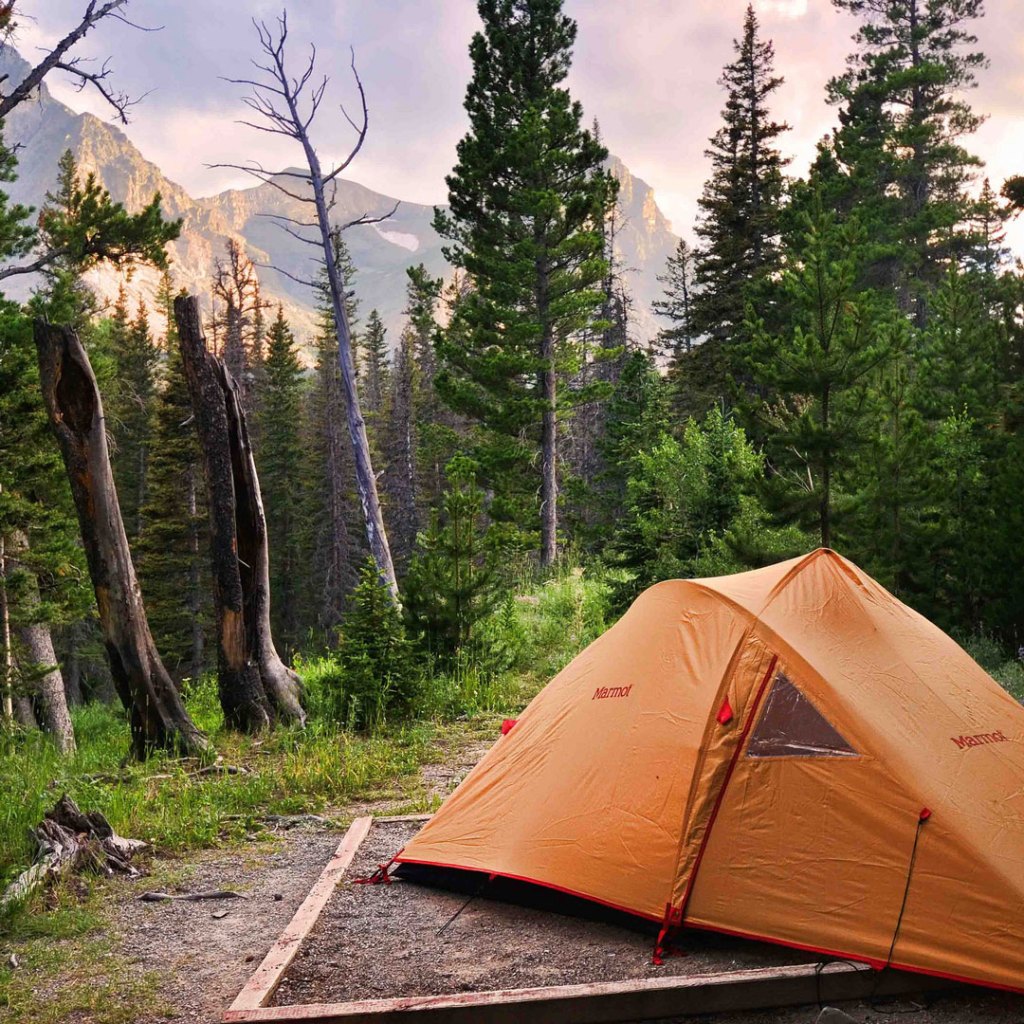
Two Medicine and East Glacier Campgrounds
Two National Park Service campgrounds are in Glacier’s southeast corner. Campsites have picnic tables and fire rings with grills. Bring your own firewood; gathering wood in the park is prohibited. All campsites are first-come, first-served.
Two Medicine Campground
Two Medicine Campground yields views of bears foraging on Rising Wolf Mountain, especially from the A and C loops. Riverfront sites are 95, 99, and 100. In early summer, ruby-crowned kinglets call out “teacher, teacher” from the trees. The campground surrounds the calmer waters of small Pray Lake, a good place for paddling, fishing, or chilly swimming. With 99 sites, the campground may have sites available later than those nearer Going-to-the-Sun Road, but it can fill up midsummer before 11am. Tenters should choose sheltered sites due to abrupt high winds that can flatten poles. Flush toilets, water, and a dump station are provided. The Loop C restrooms were rebuilt in 2015. The north-shore trail departs right from the campground, leading in both directions around Rising Wolf Mountain. A seven-minute walk or a few-minute drive connects with the boat tour and rental dock. Only 13 sites can handle RVs up to 32 feet. Primitive camping has pit toilets and no water.
Cut Bank Campground
Located 19 miles north of East Glacier off U.S. 89, Cut Bank Campground is at the end of a five-mile potholed dirt road. The ultra-quiet campsites can only fit very small RVs, and trailers are not recommended. The campground has pit toilets and no running water. Atlantic Creek runs nearby, but you’ll need to filter the water or boil it for five minutes. With only 14 sites set in deep shade under large firs, it’s a great place to escape the crowds. Atlantic Creek has fishing, and a nearby trailhead departs to Medicine Grizzly Lake and Triple Divide Pass. To locate the road, look for the campground sign six miles north of the junction of Highway 49 and U.S. 89.
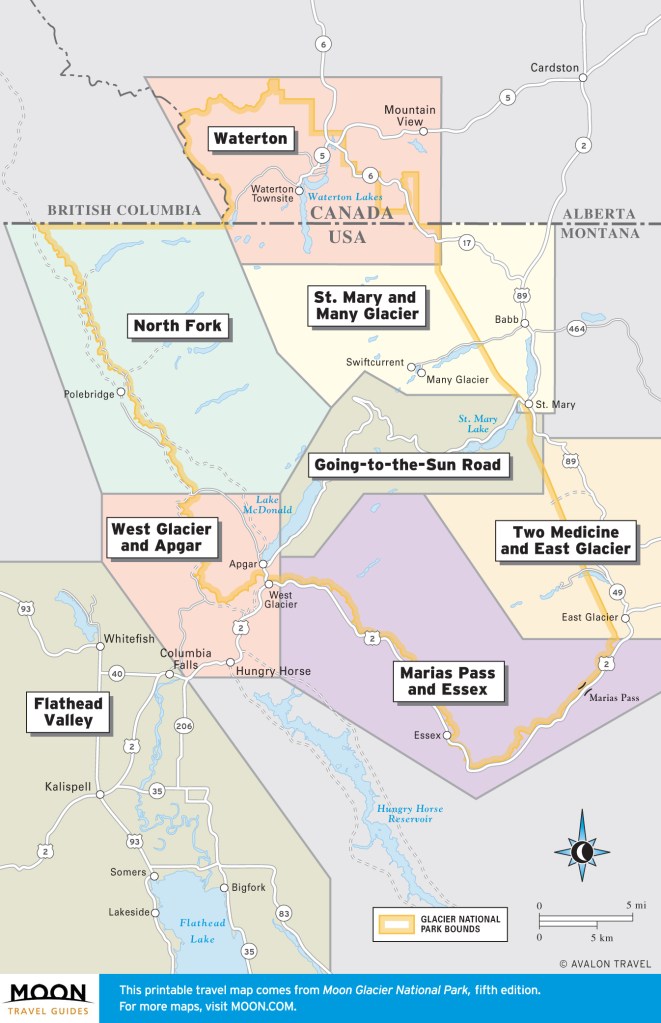
Newsletter Signup
By clicking ‘Sign Up,’ I acknowledge that I have read and agree to Hachette Book Group’s Privacy Policy and Terms of Use
Pin For Later
